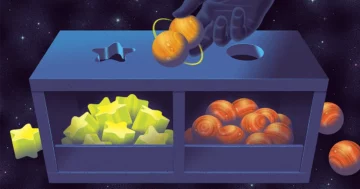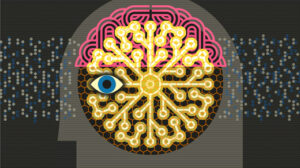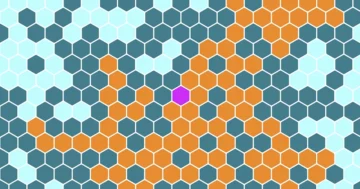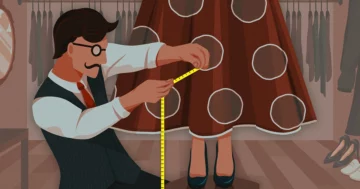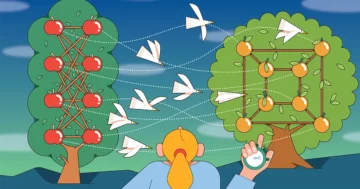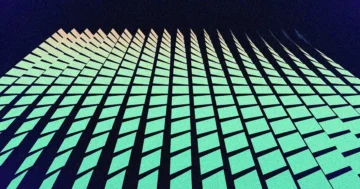
Introduction
Many complicated advances in research mathematics are spurred by a desire to understand some of the simplest questions about numbers. How are prime numbers distributed in the integers? Are there perfect cubes (like 8 = 23 or 27 = 33) that can be written as the sum of two other cubes? More generally, mathematicians might want to solve an equation. But it is often impossible to do so by tinkering with the equation itself. Instead, mathematicians find ways to connect the solutions to wildly abstract structures whose complexity encodes their secrets.
Over the past several decades, one of the most exciting lines of research in mathematics has followed this form. It has involved understanding the relationship between certain kinds of polynomial equations called elliptic curves and more esoteric objects called modular forms, which burst to prominence in mathematics in 1994 when Andrew Wiles used them to prove Fermat’s Last Theorem, among the most celebrated results of 20th century mathematics.
This past January, Ana Caraiani of Imperial College London and the University of Bonn and James Newton of the University of Oxford opened a new vein of research in this area when they proved that a relationship Wiles had established between elliptic curves and modular forms also holds for some mathematical objects called imaginary quadratic fields.
Wiles proved that certain kinds of elliptic curves are modular — meaning that there is a particular modular form that corresponds to each curve — when the two variables and two coefficients involved in defining the curve are all rational numbers, values that can be written as fractions. After his work, mathematicians endeavored to establish modularity in a broader variety of contexts. In 2001 four mathematicians proved that all elliptic curves are modular over the rational numbers (whereas Wiles had only proved this for some curves). In 2013, three mathematicians including Samir Siksek of the University of Warwick proved that elliptic curves are also modular over real quadratic fields (meaning that the variables and coefficients are taken from a number system called a real quadratic field).
As the advances mounted, one particular goal remained out of reach: proving that elliptic curves are modular over imaginary quadratic fields.
Quadratic fields are a mathematical steppingstone between the rational numbers and the real numbers, which include every possible decimal number, even those with infinite patterns to the right of the decimal point that never repeat. (This includes all the irrational numbers, like $latex sqrt{2}$ or $latex pi $.)
Introduction
Quadratic fields choose some integer — say, 5 — and include all the numbers of the form $latex a + bsqrt{5}$ where a and b are both rational numbers. If the integer in question is positive, then the resulting quadratic field is a subset of the real numbers, so it’s known as a real quadratic field.
What about elliptic curves that are defined over imaginary quadratic fields — those that are formed by taking the square root of a negative number?
That’s the problem Caraiani and Newton tackled.
Hundreds of years ago, mathematicians defined the square root of negative numbers in a straightforward way: They gave a name, i, to the square root of −1. Then the square root of any other negative number is just i times the square root of the corresponding positive number. So $latex sqrt{-5}=isqrt{5}$. Imaginary numbers play a crucial role in mathematics because for many problems, they’re easier to work with than real numbers.
But proving that elliptic curves are modular over imaginary quadratic fields has long remained out of reach, because the techniques for proving modularity over real quadratic fields don’t work.
Caraiani and Newton achieved modularity — for all elliptic curves over about half of all imaginary quadratic fields — by figuring out how to adapt a process for proving modularity pioneered by Wiles and others to elliptic curves over imaginary quadratic fields.
“That’s where the beautiful work of Caraiani and Newton came in. They improved the second step of Wiles,” said Chandrashekhar Khare of the University of California, Los Angeles.
The work is a technical achievement in its own right, and it opens the door to making progress on some of the most important questions in math in the imaginary setting.
Matchmaker, Matchmaker
Mathematicians have cared about the solutions to polynomial equations — combinations of variables raised to constant powers — since at least the ancient Greeks. The equations come in endless varieties, achieved by adjusting the quantity of variables, those variables’ coefficients, and the powers they’re raised to. $latex 3x^5+x^4−9x^3−4x^2+x−7=0$ is just one example.
Elliptic curves are polynomial equations that are at the optimal level of hardness for mathematical inquiry. There is a tidy (and widely taught) formula for finding solutions to quadratic polynomials in one variable, in which the highest power is 2, but there is no such formula for solutions to polynomials where the highest power is 5 or above. Adding more variables generally makes things more complicated as well. But elliptic curves, which have two variables and whose highest power is 3, like $latex (y^2=x^3+1)$, are challenging enough to inspire invention, without being so hard that they feel hopeless.
One of the basic questions about an elliptic curve is whether there are finitely or infinitely many rational pairs that solve it. Some elliptic curves have finitely many rational solutions, others have infinitely many, and some have none at all.
“They have this kind of funny intermediate behavior,” Caraiani said.
If you’re handed a random elliptic curve, it’s not immediately evident which category it falls into. But it’s possible to decode it by pairing it with a matching object called a modular form, whose properties reveal the answer.
Catch Me a Modular Form
Modular forms are functions studied in analysis, an advanced form of calculus. They are very symmetric and often can be translated — shifted to the left or right — without losing their appearance. In this way they have features in common with other highly symmetric functions, like the sine function, though they’re less straightforward to write down or visualize.
Every modular form comes with coefficients. You can write them down, producing a series of numbers. These numbers have very nice properties, and seem far from random. They mystified mathematicians beginning in the early 20th century, when the mathematical genius Srinivasan Ramanujan began to perceive that the patterns in the coefficients of a modular form are explained by the fact that each modular form is attached to a second kind of object called a Galois representation. Later work confirmed the link.
Elliptic curves also have Galois representations, and after Ramanujan’s work, it seemed possible that Galois representations could be interpolated between elliptic curves and modular forms: Start with one, identify its Galois representation, find the other.
“You sort of think: Elliptic curves, objects from geometry, have Galois representations, and modular forms have Galois representations — is there a match?” Siksek said.
In the late 1950s, Yutaka Taniyama and Goro Shimura proposed that there is a perfect 1-to-1 matching between certain modular forms and elliptic curves. The next decade Robert Langlands built on this idea in the construction of his expansive Langlands program, which has become one of the most far-reaching and consequential research programs in math.
If the 1-to-1 correspondence is true, it would give mathematicians a powerful set of tools for understanding the solutions to elliptic curves. For example, there’s a kind of numerical value associated with each modular form. One of math’s most important open problems (proving it comes with a million-dollar prize) — the Birch and Swinnerton-Dyer conjecture — proposes that if that value is zero, then the elliptic curve associated to that modular form has infinitely many rational solutions, and if it’s not zero, the elliptic curve has finitely many rational solutions.
But before anything like that can be tackled, mathematicians need to know that the correspondence holds: Hand me an elliptic curve, and I can hand you its matching modular form. Proving this is what many mathematicians, from Wiles to Caraiani and Newton, have been up to over the last few decades.
Look Through Your Book
Prior to Wiles’ work, mathematicians had succeeded in proving one direction of the correspondence: In some cases they could start with a modular form and find its matching elliptic curve. But going in the other direction — which is what mathematicians mean when they talk about elliptic curves being modular — was harder, and Wiles was the first to achieve it.
“Earlier people knew how to go from a modular form to an elliptic curve under certain circumstances, but this backward direction from elliptic to modular was the one that Wiles motivated,” Khare said.
Wiles proved modularity for some kinds of elliptic curves with coefficients that are rational numbers. That by itself was enough to prove Fermat’s Last Theorem by way of a contradiction. (Wiles proved that if Fermat’s Last Theorem were false, it would imply the existence of an elliptic curve that previous work had established can’t exist. Therefore, Fermat’s Last Theorem has to be true.)
As mathematicians extended Wiles’ work on elliptic curves, they followed the same method he had used to prove his initial result.
After the successes in generalizing the result to rational numbers and real quadratic fields, the obvious next extension was to imaginary quadratic fields.
“There are only two things that can happen: The field is either real or imaginary,” Caraiani said. “The real case was already understood, so it’s natural to go to the imaginary case.”
Imaginary quadratic fields have the same basic arithmetic properties as the rational and the real numbers, but Wiles’ method could not be transplanted there nearly as easily. There are many reasons why, but in particular, modular forms over imaginary quadratic fields are much less symmetric than they are over the rationals and over real quadratic fields. This relative lack of symmetry makes it harder to define their Galois representations, which are the key to establishing a match with an elliptic curve.
For years after Wiles’ Fermat proof, “the case of imaginary quadratic fields was still beyond what was possible,” Khare said. But over the last decade, a series of advances prepared the way for Caraiani and Newton’s work.
Bring Me a Ring (or Better Yet, a Field)
The first step in Wiles’ method was to establish an approximate match between elliptic curves and modular forms. The two are connected via Galois representations that are encoded in a series of numbers originating uniquely on both sides of the pairing.
Ultimately you want to show that the numbers defining the Galois representations match exactly, but in this first step it’s enough to show that they differ by some consistent margin of error. For example, you can prove that a series of numbers matches up if you can add or subtract multiples of 3 to get from each number to its corresponding number. In this light, (4, 7, 2) matches with (1, 4, 5) or with (7, 10, 8), but not with (2, 8, 3). You could also say they match if they differ by multiples of 5, 11 or any prime number (for technical but important reasons, the margin of error always has to be prime). A 2019 paper by Patrick Allen, Khare and Jack Thorne provided this kind of toehold on the problem.
“They proved theorems which give you somewhere to start,” Newton said.
Around the same time that the 2019 paper was underway, a group of 10 mathematicians was working to make additional steps of Wiles’ method work for imaginary quadratic fields. The collaboration started during a week spent at the Institute for Advanced Study and included Allen and Thorne — co-authors of the 2019 paper — as well as Caraiani and Newton.
The group’s first goal was to establish that the Galois representations coming from modular forms possess a certain kind of internal consistency. This property — which is a prerequisite for matching them with the Galois representations coming from elliptic curves — is called local-global compatibility.
The 10-person collaboration managed to do this in some special cases, but not most. As the collaboration wound down, Caraiani and Newton decided to continue working together to see if they could do more.
“We were in London at the same time, and we enjoyed talking with each other about things that showed up on that 10-author project,” Caraiani said. “We knew what were the sticking points, what were the obstructions to going further.”
Night After Night in the Dark
Shortly after they started working on their own, Caraiani and Newton landed on a strategy for going beyond the work they’d started with the larger group. It didn’t seem obviously wrong, but they also had no idea whether it would really work.
“We started with this optimistic idea that things would work out, that we could prove something a bit stronger than this 10-author paper, and eventually we did,” Newton said.
Caraiani and Newton worked on this idea for two years, and by the end of 2021 their optimism had paid off: They’d improved the local-global compatibility result made by the 10-author team. They describe how in a long, technical section that comprises the first half of their final paper, which is more than 100 pages long.
“We knew that once we had this technical piece in place, modularity would be in play,” Caraiani said.
The first step of Wiles’ method was to establish a kind of approximate modularity. The second step was the local-global compatibility result. The third step was to take their knowledge that at least a small number of curves are modular and leverage it to prove that many curves are modular. This move was possible due to what’s called a modularity lifting theorem.
“It allows you to spread modularity around,” Newton said. “If you know the modularity of something, this lifting [of] things allows you to rescue the modularity of lots of other things. You sort of propagate this modularity property in some nice way.”
A Matchless Match
Applying the lifting theorem allowed Caraiani and Newton to prove the modularity of infinitely many elliptic curves, but there were still some corner cases they couldn’t get. These were a handful of families of elliptic curves with unique properties that made them inaccessible to the lifting theorem.
But because there were so few of them, Caraiani and Newton could attack them by hand — computing their Galois representations one by one to try and establish a match.
“There we kind of had fun computing lots and lots of points on some curves,” Caraiani said.
The effort was successful, up to a point. Caraiani and Newton ultimately managed to prove that all elliptic curves are modular over about half of the imaginary quadratic fields, including those fields formed by combining the rational numbers with the square root of −1, −2, −3 or −5. For other imaginary quadratic fields, they were able to prove modularity for many, but not all, elliptic curves. (The modularity of the holdouts remains an open question.)
Their result provides a foundation for investigating some of the same basic questions about elliptic curves over imaginary quadratic fields that mathematicians pursue over the rationals and the reals. This includes the imaginary version of Fermat’s Last Theorem — though additional groundwork needs to be laid before that is approachable — and the imaginary version of the Birch and Swinnerton-Dyer conjecture.
But if mathematicians make progress in either place, Caraiani won’t be a part of it — at least not for now. After years of work on the modularity of elliptic curves, she’s ready to try something else.
“If I get a result in one direction, I don’t always like to continue only working in that direction,” she said. “So now I’ve switched my interests to something with a bit more of a geometric flavor.”
Correction: July 6, 2023
This article originally said that there is no general formula for the solutions of a polynomial equation whose highest exponent is 4 or above. The correct number is 5. The article has been corrected.
- SEO Powered Content & PR Distribution. Get Amplified Today.
- PlatoData.Network Vertical Generative Ai. Empower Yourself. Access Here.
- PlatoAiStream. Web3 Intelligence. Knowledge Amplified. Access Here.
- PlatoESG. Automotive / EVs, Carbon, CleanTech, Energy, Environment, Solar, Waste Management. Access Here.
- BlockOffsets. Modernizing Environmental Offset Ownership. Access Here.
- Source: https://www.quantamagazine.org/elliptic-curves-yield-their-secrets-in-a-new-number-system-20230706/
- :has
- :is
- :not
- :where
- ][p
- $UP
- 1
- 10
- 100
- 11
- 1994
- 2001
- 2013
- 2019
- 2021
- 27
- 7
- 8
- a
- Able
- About
- above
- ABSTRACT
- AC
- Achieve
- achieved
- achievement
- adapt
- add
- adding
- Additional
- advanced
- advances
- After
- ago
- All
- allowed
- allows
- already
- also
- always
- among
- an
- analysis
- Ancient
- and
- Andrew
- Angeles
- answer
- any
- anything
- approximate
- ARE
- AREA
- around
- article
- AS
- associated
- At
- attached
- attack
- basic
- BE
- beautiful
- because
- become
- been
- before
- began
- Beginning
- being
- Better
- between
- Beyond
- Bit
- bold
- both
- Both Sides
- broader
- built
- but
- by
- california
- called
- came
- CAN
- case
- cases
- Category
- celebrated
- Century
- certain
- challenging
- Choose
- circumstances
- collaboration
- College
- combinations
- combining
- come
- comes
- coming
- Common
- compatibility
- complexity
- complicated
- comprises
- computing
- CONFIRMED
- conjecture
- Connect
- connected
- consequential
- consistent
- constant
- construction
- contexts
- continue
- Corner
- correct
- corrected
- Corresponding
- corresponds
- could
- crucial
- curve
- decade
- decades
- decided
- defined
- defining
- describe
- desire
- DID
- differ
- direction
- distributed
- do
- Dont
- Door
- down
- due
- during
- each
- Early
- easier
- easily
- effort
- either
- Elliptic
- else
- end
- Endless
- enough
- equations
- error
- establish
- established
- establishing
- Even
- eventually
- Every
- evident
- exactly
- example
- exciting
- exist
- explained
- extension
- fact
- Falls
- false
- families
- far
- far-reaching
- Features
- feel
- few
- field
- Fields
- final
- Find
- finding
- First
- followed
- For
- form
- formed
- forms
- formula
- Foundation
- four
- from
- fun
- function
- functions
- funny
- further
- gave
- General
- generally
- genius
- geometry
- get
- Give
- Go
- goal
- going
- groundwork
- Group
- Group’s
- had
- Half
- hand
- handful
- happen
- Hard
- harder
- Have
- he
- highest
- highly
- his
- holds
- How
- How To
- http
- HTTPS
- i
- idea
- identify
- if
- imaginary
- immediately
- Imperial
- Imperial College
- Imperial College London
- important
- impossible
- improved
- in
- inaccessible
- include
- included
- includes
- Including
- initial
- inquiry
- inspire
- instead
- Institute
- interests
- Intermediate
- internal
- into
- Invention
- involved
- IT
- ITS
- itself
- January
- July
- just
- just one
- Key
- Kind
- Know
- knowledge
- known
- Lack
- larger
- Last
- Late
- later
- least
- left
- less
- Level
- Leverage
- lifting
- light
- like
- lines
- LINK
- London
- Long
- los
- Los Angeles
- losing
- made
- magazine
- make
- MAKES
- Making
- managed
- many
- Margin
- Match
- matching
- math
- mathematical
- mathematics
- me
- mean
- meaning
- method
- might
- modular
- more
- most
- motivated
- move
- much
- my
- name
- Natural
- nearly
- Need
- needs
- negative
- never
- New
- Newton
- next
- nice
- night
- no
- now
- number
- numbers
- object
- objects
- obvious
- of
- off
- often
- on
- once
- ONE
- only
- open
- opened
- opens
- optimal
- Optimism
- Optimistic
- or
- originally
- originating
- Other
- Others
- out
- over
- own
- Oxford
- pages
- paid
- pairing
- pairs
- Paper
- part
- particular
- past
- patterns
- People
- perfect
- piece
- pioneered
- Place
- plato
- Plato Data Intelligence
- PlatoData
- Play
- Point
- points
- positive
- possess
- possible
- power
- powerful
- powers
- prepared
- previous
- Prime
- Problem
- problems
- process
- producing
- Programs
- Progress
- project
- prominence
- proof
- properties
- property
- proposed
- proposes
- Prove
- proved
- provided
- provides
- quadratic
- Quantamagazine
- quantity
- question
- Questions
- raised
- random
- Rational
- reach
- ready
- real
- really
- reasons
- relationship
- relative
- remained
- remains
- repeat
- representation
- rescue
- research
- result
- resulting
- Results
- reveal
- right
- Ring
- ROBERT
- Role
- root
- Said
- same
- say
- Second
- Section
- see
- seem
- seemed
- Series
- set
- setting
- several
- she
- shifted
- show
- showed
- Sides
- since
- small
- So
- Solutions
- SOLVE
- some
- something
- somewhere
- special
- spent
- spread
- square
- start
- started
- Step
- Steps
- sticking
- Still
- straightforward
- Strategy
- stronger
- studied
- Study
- successful
- such
- switched
- system
- Take
- taken
- taking
- Talk
- talking
- team
- Technical
- techniques
- than
- that
- The
- their
- Them
- then
- There.
- therefore
- These
- they
- things
- Think
- Third
- this
- those
- though?
- three
- Through
- time
- times
- to
- together
- tools
- translated
- true
- try
- two
- ucla
- Ultimately
- under
- understand
- understanding
- understood
- Underway
- unique
- uniquely
- university
- University of California
- University of Oxford
- used
- value
- Values
- variables
- variety
- version
- very
- via
- visualize
- want
- was
- Way..
- ways
- we
- webp
- week
- WELL
- were
- What
- when
- whereas
- whether
- which
- whose
- why
- widely
- with
- without
- Work
- work out
- worked
- working
- would
- would give
- write
- written
- Wrong
- years
- yet
- Yield
- you
- Your
- zephyrnet
- zero





